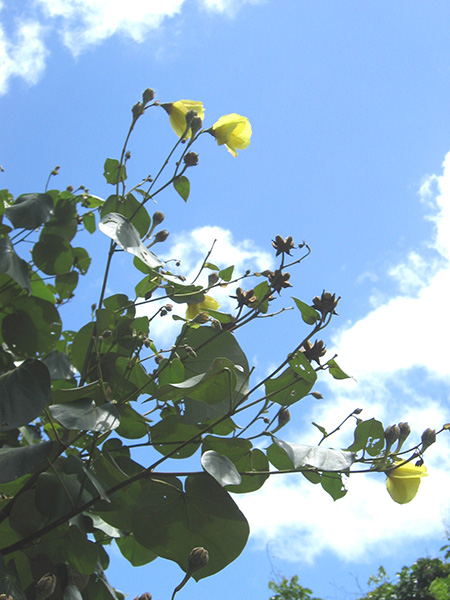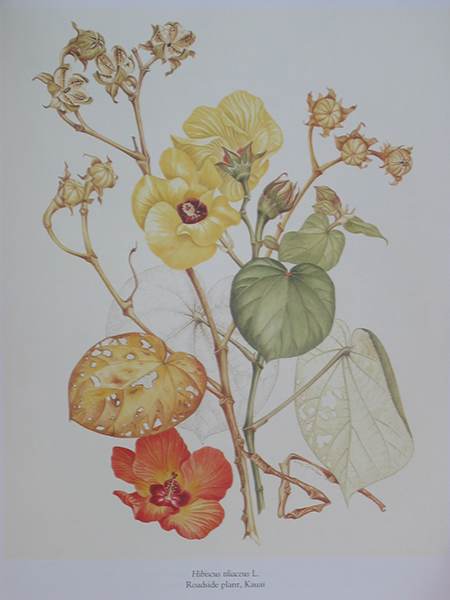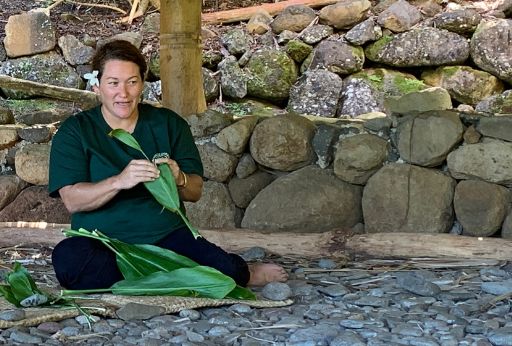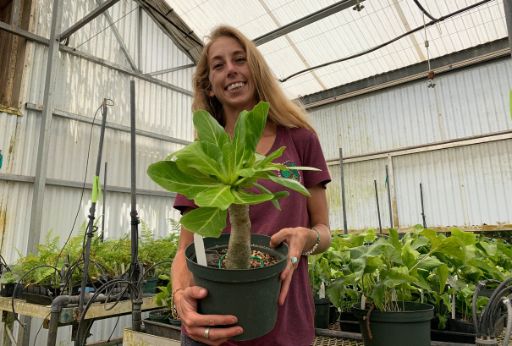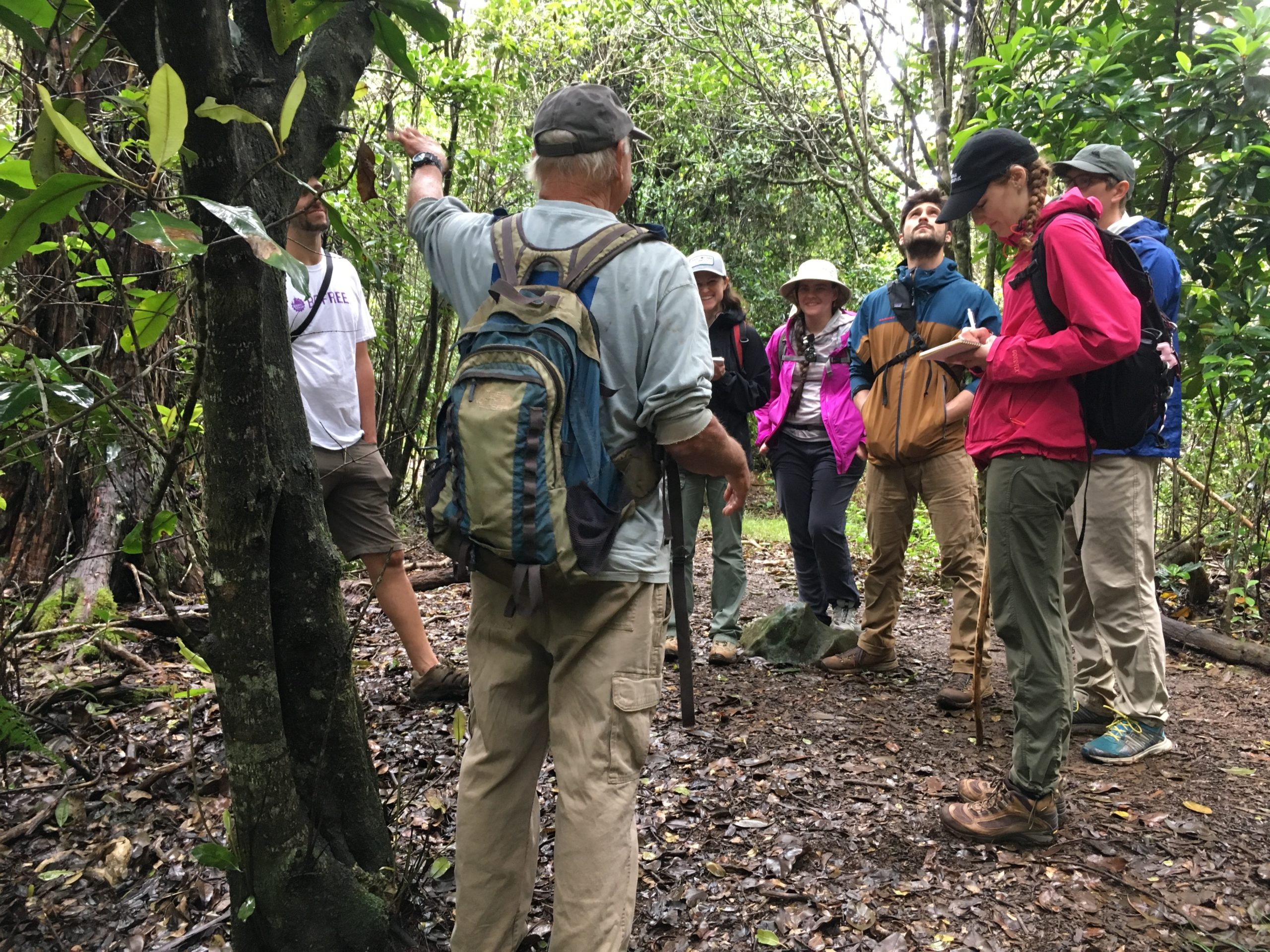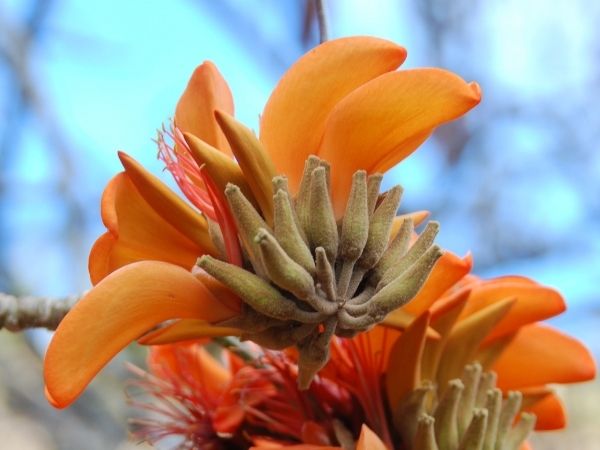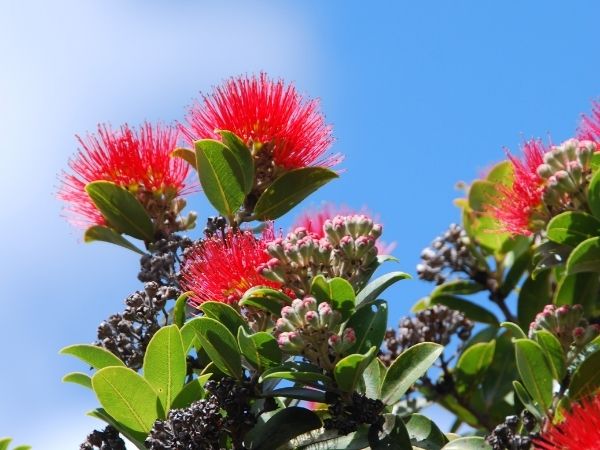Tropical Plant Database - Plant Details
Hibiscus tiliaceus
Click on any heading above to view more information about this plant
Conservation Status
- IUCN: least concern
- USFWS: None
Family: MALVACEAE
Genus: Hibiscus
Species: tiliaceus
Species Author: L.
Vernacular: Hau, O-hamabo, Mahoe, Sea Hibiscus, Fau - Samoan [Whistler W 1342]
Synonyms: Hibiscus abutiloides, Paritium tiliaceum, Pariti tiliaceum var. potteri, Talipariti tiliaceum
Genus: Hibiscus
Species: tiliaceus
Species Author: L.
Vernacular: Hau, O-hamabo, Mahoe, Sea Hibiscus, Fau - Samoan [Whistler W 1342]
Synonyms: Hibiscus abutiloides, Paritium tiliaceum, Pariti tiliaceum var. potteri, Talipariti tiliaceum
Hibiscus tiliaceus is a evergreen shrub or small tree, reaching 10(-20) m tall, with low spreading branches and smooth gray bark. Leaves are spirally arranged with a pointed tip and slightly toothed, dark green above and whitish and short-hairy below. The long-stemmed leaves are rounded, heart-shaped, with several major veins. The few-flowered inflorescences are found at the branch tips or leaf angles. The flowers are large and conspicuous, bright yellow in the early morning,turning dark reddish purple before dropping off in the evening. The flowers open at about 9 am and drop off at about 4 pm. The filaments of the stamens are joined together into a light yellow tube and the stigmas are a deep crimson purple. The flowers appear in early summer. The capsules are somewhat spherical, topped by the persistent sepals. The seed are black or sometimes brown in color including the seed coat.
(Lim, K. et al.(editors) 2001. A Guide to Mangroves of Singapore.)
(Kepler,A.K. 1984. Hawaiian Heritage Plants.)
(Lim, K. et al.(editors) 2001. A Guide to Mangroves of Singapore.)
(Kepler,A.K. 1984. Hawaiian Heritage Plants.)
A slimy, juicy sap found in the flower bud and in the bark was used as a mild laxative. For babies and young children, the flower buds were used. For adults and older children, the small white dome-shaped bump inside the bottom of the flower petals was used. The buds were also chewed and eaten for dry-throat. Slime from soaking the bark of the stems was medicine for congested chests. The lubricant quality of the inner bark was of value as an enema or could assist in the passage of a baby at childbirth.
Hibiscus tiliaceus is use to cool fevers and soothe coughs (leaves), treat dysentery (bark), ear infections and abscesses (flowers) and as laxative (bark and flower).
(Kepler,A.K. 1984. Hawaiian Heritage Plants.)
(Lebler, B.A. 1977. Wildflowers of South-Eastern Queensland.)
Hibiscus tiliaceus is use to cool fevers and soothe coughs (leaves), treat dysentery (bark), ear infections and abscesses (flowers) and as laxative (bark and flower).
(Kepler,A.K. 1984. Hawaiian Heritage Plants.)
(Lebler, B.A. 1977. Wildflowers of South-Eastern Queensland.)
Besides being such a great ornamental tree, Hibiscus tiliaceus has many traditional uses around the world. In Tahiti, the leaves were wrapped around food to be cooked, and were also used as plates. The leaves are fed to cattle in Southeast Asia. The roots and young shoots are reported to have been eaten by aborigines in Queensland. The Polynesians ate the young leaves and used the bast fibres to make ropes and the adult bark to make "tapa", a traditional clothing used in pre-European Polynesia. On some islands the dried inner bark is used to make "grass skirts" worn by dancers. On Pohnpei, the fresh inner bark is used for squeezing the liquid from freshly pounded kava roots. A Singaporean source states that the fibre is used for strings and ropes for making fishing nets and caulking boats. In Hawaii the wood is used to make outrigger canoes. The unprocessed bark is also used by hunters or farmers as an immediate source of cordage for binding game or produce.
(Lim,K et al. (editors) 2001. A Guide to Mangroves of Singapore.)
(Lebler, B.A. 1977. Wildflowers of South-Eastern Queensland.)
(Kepler,A.K. 1984. Hawaiian Heritage Plants.)
(Information for this species compiled and recorded by Camelia Cirnaru, NTBG Consultant.)
(Lim,K et al. (editors) 2001. A Guide to Mangroves of Singapore.)
(Lebler, B.A. 1977. Wildflowers of South-Eastern Queensland.)
(Kepler,A.K. 1984. Hawaiian Heritage Plants.)
(Information for this species compiled and recorded by Camelia Cirnaru, NTBG Consultant.)
Hibiscus tiliaceus is a tree native to the tropical shores of the Pacific and Indian oceans, today cultivated or naturalised throughout the tropical and subtropical regions of the world. The beach hibiscus is a coastal tree with a spreading crown found on sand dunes and ridges above the beach, associated with mangroves, or sometimes around freshwater streams in low country or even extending up into wet valleys and mountain slopes.
Seeds and cuttings of hau were brought by early Polynesian voyagers to Hawai'i Nei, and planted by the settlers to yield a light-weight tough white wood with a brown heart. Hau is found and used throughout tropical and subtropical Polynesia, Melanesia and Micronesia and is held in high regard for its usefulness to the traditional life of oceanic people.
(Lim,K and all. 2001 (editors). A Guide to Mangroves of Singapore.)
(Lebler, B.A. 1977. Wildflowers of South-Eastern Queensland.)
(Kepler,A.K. 1984. Hawaiian Heritage Plants.)
Seeds and cuttings of hau were brought by early Polynesian voyagers to Hawai'i Nei, and planted by the settlers to yield a light-weight tough white wood with a brown heart. Hau is found and used throughout tropical and subtropical Polynesia, Melanesia and Micronesia and is held in high regard for its usefulness to the traditional life of oceanic people.
(Lim,K and all. 2001 (editors). A Guide to Mangroves of Singapore.)
(Lebler, B.A. 1977. Wildflowers of South-Eastern Queensland.)
(Kepler,A.K. 1984. Hawaiian Heritage Plants.)
In the old days this plant was so highly valued that permission to cut it was required of the village chief. One Hawai'i legend says that hau is a sister of the goddess Hina, changed into a tree. The people of Tahiti say hau is the grandchild of heaven and earth. Some people equate the brief span of the hau flower as representative of the transitory nature of human life.
(Kepler,A.K. 1984. Hawaiian Heritage Plants.)
(Kepler,A.K. 1984. Hawaiian Heritage Plants.)
Hibiscus tiliaceus is grown throughout the tropics mainly as an ornamental tree for landscaping, as it is very ornamental, with its large heart-shaped leaves and dense foliage.
Today it is often called "hau bush" in Hawai'i and is sometimes regarded as an invasive plant, as it has taken over some areas covering many acres, at the same time creating windbreaks and stabilizing the soil.
Hibiscus tiliaceus is listed as invasive in Florida and has naturalised elsewhere, so care should be taken to prevent it from spreading in areas where it is not native.
(Lebler, B.A. 1977. Wildflowers of South-Eastern Queensland.)
(Kepler,A.K. 1984. Hawaiian Heritage Plants.)
Today it is often called "hau bush" in Hawai'i and is sometimes regarded as an invasive plant, as it has taken over some areas covering many acres, at the same time creating windbreaks and stabilizing the soil.
Hibiscus tiliaceus is listed as invasive in Florida and has naturalised elsewhere, so care should be taken to prevent it from spreading in areas where it is not native.
(Lebler, B.A. 1977. Wildflowers of South-Eastern Queensland.)
(Kepler,A.K. 1984. Hawaiian Heritage Plants.)
- 011697 - collected by Art Whistler in Unknown
- 094711 - collected by C. G. Lloyd in 0001
- 021931 - collected by P. Kluding in 1968
- 075286 - collected by Art Whistler in 1971
- 044644 - collected by Derral Herbst in 1972
- 044645 - collected by Derral Herbst in 1972
- 081274 - collected by Michelle & Ole Hamann in 1972
- 021736 - collected by Keith Woolliams in 1973
- 075285 - collected by Art Whistler in 1973
- 075288 - collected by Art Whistler in 1974
- 075284 - collected by Art Whistler in 1975
- 075287 - collected by Art Whistler in 1980
- 075282 - collected by Art Whistler in 1981
- 044642 - collected by Shawn Lum in 1983
- 044648 - collected by T. G. Lammers in 1984
- 059726 - collected by Art Whistler in 1985
- 059729 - collected by Art Whistler in 1985
- 059728 - collected by Art Whistler in 1985
- 044643 - collected by Tim Flynn in 1985
- 044647 - collected by Richard A. Howard in 1985
- 059727 - collected by Art Whistler in 1986
- 044646 - collected by Lynwood Hume in 1987
- 002021 - collected by Tim Flynn in 1987
- 006899 - collected by David H. Lorence in 1988
- 006458 - collected by David H. Lorence in 1988
- 003152 - collected by David H. Lorence in 1989
- 003313 - collected by Art Whistler in 1989
- 009173 - collected by Tim Flynn in 1991
- 075283 - collected by Art Whistler in 1992
- 016653 - collected by Tim Flynn in 1995
- 042817 - collected by Art Whistler in 1995
- 038086 - collected by Art Whistler in 1995
- 016715 - collected by David H. Lorence in 1995
- 021069 - collected by David H. Lorence in 1996
- 026359 - collected by Steve Perlman in 1997
- 034650 - collected by Michael J. Balick in 1997
- 022534 - collected by Melany H. Chapin in 1997
- 022525 - collected by Melany H. Chapin in 1997
- 022535 - collected by Melany H. Chapin in 1997
- 021623 - collected by Melany H. Chapin in 1997
- 021593 - collected by Melany H. Chapin in 1997
- 021622 - collected by Melany H. Chapin in 1997
- 021597 - collected by Melany H. Chapin in 1997
- 021627 - collected by Melany H. Chapin in 1997
- 021628 - collected by Melany H. Chapin in 1997
- 021626 - collected by Melany H. Chapin in 1997
- 021615 - collected by Melany H. Chapin in 1997
- 022490 - collected by Tim Flynn in 1997
- 034630 - collected by Michael J. Balick in 1998
- 089564 - collected by Art Whistler in 1998
- 028730 - collected by Tim Flynn in 1999
- 042876 - collected by Art Whistler in 2000
- 033556 - collected by Hank Oppenheimer in 2001
- 038721 - collected by P. Raynor in 2001
- 035348 - collected by David H. Lorence in 2001
- 035112 - collected by David H. Lorence in 2001
- 037101 - collected by Diane Ragone in 2001
- 052959 - collected by Michael J. Balick in 2001
- 051522 - collected by Stephanie Dunbar in 2002
- 053069 - collected by Michael J. Balick in 2002
- 087522 - collected by Michael J. Balick in 2002
- 046208 - collected by A. Dores in 2002
- 052905 - collected by B. Ekiek in 2002
- 039698 - collected by Jon Price in 2003
- 046128 - collected by A. Dores in 2003
- 043541 - collected by A. Dores in 2003
- 046223 - collected by E. Albert Amor in 2003
- 043951 - collected by K. R. Wood in 2004
- 043949 - collected by Steve Perlman in 2004
- 043492 - collected by Francisca Sohl in 2004
- 043486 - collected by Francisca Sohl in 2004
- 043472 - collected by Francisca Sohl in 2004
- S062135 - collected by Tim Flynn in 2004
- 047056 - collected by Tim Flynn in 2004
- 044136 - collected by Steve Perlman in 2005
- 070863 - collected by L. M. Crago in 2005
- 049075 - collected by P. Emos Eperiam in 2006
- 021737 - collected by Derral Herbst in 2007
- 067680 - collected by Nancy Vander Velde in 2009
- 070699 - collected by Natalia Tangalin in 2013
- S066909 - collected by Tim Flynn in 2013
- W086757 - collected by Tim Flynn in 2013
- Unassigned - collected by Tim Flynn in 2013
- 092429 - collected by Gregory M. Plunkett in 2014
- 094999 - collected by Elliot Gardner in 2022
- 093558 - collected by Justine Haltom and Matt Kahokuloa in 2022
- 091907 - collected by Quinn Campbell in 2023
- 093769 - collected by David H. Lorence in 2024
We currently have 88 herbarium specimens for Hibiscus tiliaceus in our collection. Click on any specimen below to view the herbarium sheet data.
.svg)

